Related Research Articles

Hibernation is a state of minimal activity and metabolic depression undergone by some animal species. Hibernation is a seasonal heterothermy characterized by low body-temperature, slow breathing and heart-rate, and low metabolic rate. It most commonly occurs during winter months.

A bumblebee is any of over 250 species in the genus Bombus, part of Apidae, one of the bee families. This genus is the only extant group in the tribe Bombini, though a few extinct related genera are known from fossils. They are found primarily in higher altitudes or latitudes in the Northern Hemisphere, although they are also found in South America, where a few lowland tropical species have been identified. European bumblebees have also been introduced to New Zealand and Tasmania. Female bumblebees can sting repeatedly, but generally ignore humans and other animals.

The monarch butterfly or simply monarch is a milkweed butterfly in the family Nymphalidae. Other common names, depending on region, include milkweed, common tiger, wanderer, and black-veined brown. It is amongst the most familiar of North American butterflies and an iconic pollinator, although it is not an especially effective pollinator of milkweeds. Its wings feature an easily recognizable black, orange, and white pattern, with a wingspan of 8.9–10.2 cm (3.5–4.0 in). A Müllerian mimic, the viceroy butterfly, is similar in color and pattern, but is markedly smaller and has an extra black stripe across each hindwing.

The small tortoiseshell is a colourful Eurasian butterfly in the family Nymphalidae. Adults feed on nectar and may hibernate over winter; in warmer climates they may have two broods in a season. While the dorsal surface of the wings is vividly marked, the ventral surface is drab, providing camouflage. Eggs are laid on the common nettle, on which the larvae feed.

An ectotherm, more commonly referred to as a "cold-bloodedanimal", is an animal in which internal physiological sources of heat are of relatively small or of quite negligible importance in controlling body temperature. Such organisms rely on environmental heat sources, which permit them to operate at very economical metabolic rates.

Pieris brassicae, the large white, also called cabbage butterfly, cabbage white, cabbage moth (erroneously), or in India the large cabbage white, is a butterfly in the family Pieridae. It is a close relative of the small white, Pieris rapae.

Gonepteryx rhamni, commonly named the common brimstone, is a butterfly of the family Pieridae. It lives throughout the Palearctic zone and is commonly found across Europe, Asia, and North Africa. Across much of its range, it is the only species of its genus, and is therefore simply known locally as the brimstone. Its wing span size is 60–74 mm (2.4–2.9 in). It should not be confused with the Brimstone moth Opisthograptis luteolata.
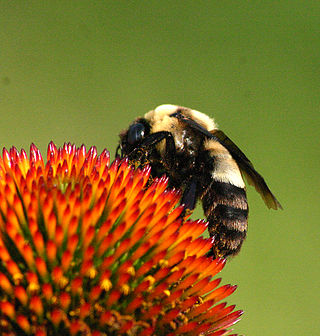
Bombus fraternus is an endangered species of bumblebee known commonly as the Southern Plains bumblebee. It is native to the United States east of the Rocky Mountains. It is most often encountered in the southern Great Plains and along the Gulf Coastal Plain. This species has been found as far north as New Jersey and North Dakota, and as far south as Florida along the Gulf Coastal Plain into the state of Chihuahua in Mexico. This species was uncommon historically, but having faced declines in population; its estimated abundance is less than 15% of historical numbers.

Insect winter ecology describes the overwinter survival strategies of insects, which are in many respects more similar to those of plants than to many other animals, such as mammals and birds. Unlike those animals, which can generate their own heat internally (endothermic), insects must rely on external sources to provide their heat (ectothermic). Thus, insects persisting in winter weather must tolerate freezing or rely on other mechanisms to avoid freezing. Loss of enzymatic function and eventual freezing due to low temperatures daily threatens the livelihood of these organisms during winter. Not surprisingly, insects have evolved a number of strategies to deal with the rigors of winter temperatures in places where they would otherwise not survive.

A hibernaculum is a place in which an animal seeks refuge, such as a bear using a cave to overwinter. The word can be used to describe a variety of shelters used by many kinds of animals, including insects, toads, lizards, snakes, bats, rodents, and primates of various species.
Bombus polaris is a common Arctic bumblebee species. B. polaris is one of two bumblebees that live above the Arctic Circle. The other is its social parasite Bombus hyperboreus. B. polaris is a social bee that can survive at near freezing temperatures. It has developed multiple adaptations to live in such cold temperatures. B. polaris has a thicker coat of hair than most bees, utilizes thermoregulation, and makes insulated nests.
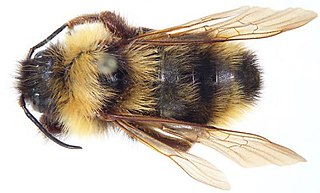
Bombus suckleyi is a species of bumblebee known commonly as Suckley's cuckoo bumblebee, named after biologist George Suckley. Suckley's bumble bee is a generalist pollinator and represents a rare group of obligate, parasitic bumble bees. Suckley's bumble bee is a social-parasite because it invades the nests of the host bumble bees, including the western bumble bee, and relies on host species workers to provision its larvae. It is native to northwestern North America, including Alaska and parts of western and central Canada and the western United States.

Bombus pensylvanicus, the American bumblebee, is a threatened species of bumblebee native to North America. It occurs in eastern Canada, throughout much of the Eastern United States, and much of Mexico.
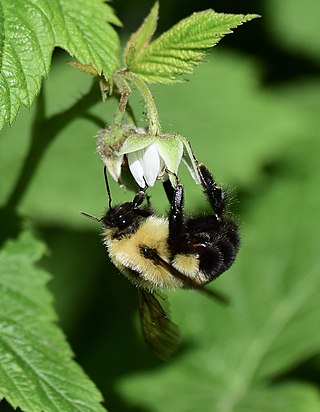
The two-spotted bumble bee is a species of social bumble bee found in the eastern half of the United States and the adjacent south-eastern part of Canada. In older literature this bee is often referred to as Bremus bimaculatus, Bremus being a synonym for Bombus. The bee's common name comes from the two yellow spots on its abdomen. Unlike many of the other species of bee in the genus Bombus,B. bimaculatus is not on the decline, but instead is very stable. They are abundant pollinators that forage at a variety of plants.
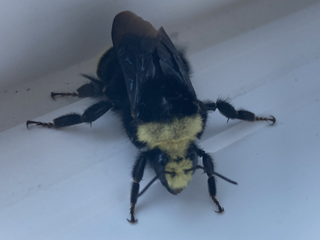
Bombus vosnesenskii, the yellow-faced bumblebee, is a species of bumblebee native to the west coast of North America, where it is distributed from British Columbia to Baja California. It is the most abundant species of bee in this range, and can be found in both urban and agricultural areas. Additionally, B. vosnesenskii is utilized as an important pollinator in commercial agriculture, especially for greenhouse tomatoes. Though the species is not currently experiencing population decline, urbanization has affected its nesting densities, and early emergence of the B. vosnesenskii has been implicated in the increasing lack of bee diversity on the West coast.

Bombus frigidus, the frigid bumblebee, is a rare species of bumblebee largely found in Canada and parts of the United States.

Bombus affinis, commonly known as the rusty patched bumble bee, is a species of bumblebee endemic to North America. Its historical range in North America has been throughout the east and upper Midwest of the United States, north to Ontario, Canada, where it is considered a "species at risk", east to Quebec, south to Georgia, and west to the Dakotas. Its numbers have declined in 87% of its historical habitat range. On January 10, 2017, the United States Fish and Wildlife Service placed B. affinis on the list of endangered species, making the rusty patched bumblebee the first bee to be added to the list in the continental United States.
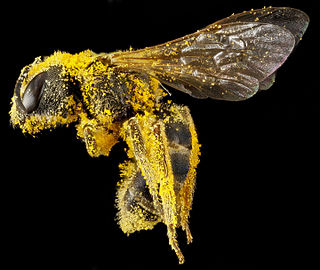
Halictus ligatus is a species of sweat bee from the family Halictidae, among the species that mine or burrow into the ground to create their nests. H. ligatus, like Lasioglossum zephyrus, is a primitively eusocial bee species, in which aggression is one of the most influential behaviors for establishing hierarchy within the colony, and H. ligatus exhibits both reproductive division of labor and overlapping generations.

Potato leafhopper belongs to family Cicadellidae and genus Empoasca within order Hemiptera. In North America they are a serious agricultural pest. Every year millions of dollars are lost from reduced crop yields and on pest management. Crops that are impacted the most are potatoes, clover, beans, apples and alfalfa.

Lasioglossum sordidum, also referred to as the small native bee, is one of the smallest native bees found in New Zealand.
References
- ↑ Savedge, Jenn. "The Difference Between Hibernation and Torpor". ThoughtCo. Dotdash. Retrieved 14 December 2020.
- ↑ Vanessa, Fonesca. "Nymphalis antiopa". Animal Diversity Web. University of Michigan Museum of Zoology. Retrieved 4 October 2013.
- ↑ Trudeau, M.; Y. Mauffette; S. Rochefort; E. Han; E.Bauce (2010). "Impact of Host Tree on Forest Tent Caterpillar Performance and Offspring Overwintering Mortality". Environ. Entomol. 39 (2): 498–504. doi: 10.1603/EN09139 . PMID 20388280. S2CID 6500698.
- ↑ Pollard, E.; Hall, M. L. (1980). "Possible movement of Gonepteryx rhamni (L.) (Lepidoptera: Pieridae) between hibernating and breeding areas". Entomologist's Gazette. 31: 217–220. ISSN 0013-8894.
- ↑ Pullin, A. S.; Bale, J. S.; Fontaine, X. L. R. (1991). "Physiological Aspects of Diapause and Cold Tolerance during Overwintering in Pieris Brassicae". Physiological Entomology. 16 (4): 447–56. doi:10.1111/j.1365-3032.1991.tb00584.x. S2CID 85922279.
- ↑ Chauhan, Avinash (2015). STUDIES ON PESTS AND DISEASES OF BUMBLE BEE, Bombus haemorrhoidalis Smith (Thesis thesis).
- ↑ Williams, Paul. Bumble Bees of the Western United States.
- ↑ Kukuk, Penelope F.; Schwarz, Michael (1987-01-01). "Intranest Behavior of the Communal Sweat Bee Lasioglossum (Chilalictus) erythrurum (Hymenoptera: Halictidae)". Journal of the Kansas Entomological Society. 60 (1): 58–64. JSTOR 25084866.
- ↑ Heinrich, Bernd. "How Do Birds Survive The Winter?". AllAboutBirds. The Cornell Lab. Retrieved 14 December 2020.
- ↑ Taki, Tarek Siddiki (2023-08-08). "Overwintering Plants: 4 Easy tips" . Retrieved 2023-09-07.
{{cite web}}: CS1 maint: url-status (link) - ↑ "Scheduling Guidelines for Overwintered Crops | Winter Growing Guide | Johnny's Selected Seeds". www.johnnyseeds.com. Retrieved 2020-10-12.